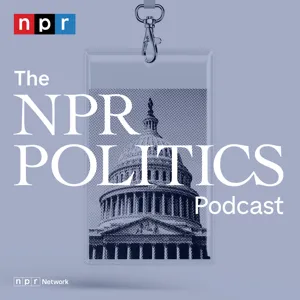Podcast Summary
Supreme Court's Ruling on Roe v Wade: A Shift in Legal Power: The Supreme Court's decision to overturn Roe v Wade marks a significant shift in power, with Republican-appointed justices abandoning judicial restraint and planning to remake the country with no regard for public reaction or democratic process.
The Supreme Court's decision to overturn Roe v Wade represents a significant shift in legal power, with six Republican-appointed justices now holding the majority. This moment goes beyond the specifics of the case, as Chief Justice John Roberts' concurring opinion highlights the abandonment of judicial restraint. The court's ruling is not just about abortion but sets a precedent for how the court will wield its power going forward. The Republican-appointed justices, now in control, plan to remake the country as they see fit, with no concern for public reaction or democratic process. This shift from constitutional reasoning to raw power is a significant development, and the court's actions will have far-reaching consequences.
The debate on Roe v. Wade goes beyond political power and precedent, it's about bodily and family autonomy.: The Supreme Court's decision to overturn Roe v. Wade not only changes the legal landscape for reproductive rights but also threatens the core idea of freedom as the ability to define and maintain one's family and personal autonomy, as established in various historical cases.
The ongoing debate surrounding the Supreme Court's decision to overturn Roe v. Wade goes beyond raw political power and disregard for precedent. It also challenges the fundamental concept of bodily autonomy and family autonomy, which are essential components of freedom as defined by the 14th Amendment. These unenumerated rights, protected under substantive due process, have been established in various cases throughout history, from Myers to Loving v. Virginia. Ignoring this historical context and framing of the 14th Amendment risks oversimplifying the significance of the current situation. The court's actions not only change the legal landscape for reproductive rights but also threaten the core idea of freedom as the ability to define and maintain one's family and personal autonomy.
Family rights and personal autonomy in American law: Landmark cases like Griswold, Roe v. Wade, and Obergefell established individual rights to family autonomy, bodily integrity, and personal life choices, which are crucial for personal freedom.
The rights to family autonomy, bodily integrity, and the ability to make personal life choices, as established in landmark cases like Griswold, Roe v. Wade, and Obergefell, are closely linked and have been under scrutiny in recent debates over critical race theory and education. These rights, which allow individuals to construct their families as they choose, are seen as essential to personal freedom. Roe v. Wade, for instance, granted women the right to terminate a pregnancy up until fetal viability, while Casey upheld this right but changed the test used to evaluate it. The case of Loving v. Virginia, which established the right to interracial marriage, was also referenced in the debate, as conservatives argued that rights not explicitly mentioned in the Constitution or not widely adopted historically do not exist. However, the dissenting justices pointed out that if this test were applied to Loving, there would be no basis for finding that right. Overall, these cases demonstrate the importance of personal autonomy and family rights in American law.
The debate over Roe v. Wade goes beyond just abortion rights: The Supreme Court's decision to overturn Roe v. Wade raises questions about the role of the Court in interpreting constitutional rights and the limits of stare decisis. The inconsistent application of these principles in recent rulings fuels concerns about the motivations behind the Court's decisions and their potential impact on other fundamental rights.
The debate surrounding the overturning of Roe v. Wade goes beyond just the right to abortion. It raises questions about the role of the Supreme Court in interpreting constitutional rights and the limits of stare decisis, or the principle of adhering to precedent. The dissenting justices argue that some fundamental rights, such as bodily autonomy and family autonomy, are deeply rooted in history and tradition and should not be subject to change based on political or societal shifts. The majority, on the other hand, argues that these rights should be left to the democratic process and not decided by the courts. However, the inconsistency in this argument was highlighted when the court issued a ruling in Bruen that went against this principle, asserting the right to concealed carry as a fundamental right that cannot be left to the states to decide. This inconsistency raises concerns about the motivations behind the court's decision and the potential consequences for other fundamental rights.
The debate over abortion rights goes beyond morality to include the legal principle of stare decisis: The principle of stare decisis, which emphasizes upholding past court decisions, adds complexity to the abortion rights debate, with some arguing it hinders error correction and prevents the court from getting it right.
The ongoing debate surrounding the Supreme Court's decision on abortion rights is not just about the morality of the issue, but also about the legal principle of stare decisis. Stare decisis is a legal doctrine that emphasizes the importance of upholding past court decisions and not changing the law based on the composition of the court. It's a way for the court to maintain public legitimacy and appear above politics. However, some justices, like Clarence Thomas, believe that this principle can hinder error correction and prevent the court from getting it right. The debate around stare decisis adds complexity to the abortion rights issue, making it a multifaceted discussion that goes beyond a simple pro-choice or pro-life stance.
Supreme Court's Decision: A Divide in Philosophies: The Supreme Court's decision to overturn Roe v. Wade and Casey reveals a stark contrast between justices, with the majority disregarding public opinion and potential consequences, while dissenters prioritize adherence to principles and societal impact.
The Supreme Court's recent decision to overturn Roe v. Wade and Casey has exposed a stark contrast between the majority and dissenting justices. While the majority appears unfazed by potential public backlash and the implications of their decision, the dissenters express deep concern for the court's legitimacy and the potential consequences on various aspects of society. The majority's approach to stare decisis, as stated in their opinion, seems to prioritize their own judgment and disregard for public opinion, whereas the dissenters advocate for adhering to long-standing principles and considering the potential impact on the system and society. This divide highlights the significant differences in philosophies and priorities among the justices.
Chief Justice Roberts voices concerns over Supreme Court's handling of controversial cases: Roberts expressed his preference for a more measured approach, but failed to garner support for a compromise, highlighting a potential ideological divide within the court.
Chief Justice John Roberts expressed his concern over the Supreme Court's handling of controversial cases through the emergency docket, which he believes lacks transparency and risks damaging the court's reputation. Roberts, who has previously sided with liberal justices, expressed his preference for a more measured approach to overturning landmark decisions like Roe v. Wade. However, in the Dobbs v. Jackson Women's Health Organization case, he failed to garner support for a compromise that would have upheld a 15-week abortion ban while preserving Roe v. Wade. Roberts' concurrence reflects his belief that the court's current approach to significant cases is unnecessary, hasty, and potentially damaging to the institution. His actions suggest a temperamental difference with his conservative colleagues, who may prioritize ideological outcomes over the court's reputation and stability.
Steward of the Court: Roberts prioritizes stability and public trust: Chief Justice Roberts values maintaining public trust and court stability over overturning past decisions, even if he disagrees with them.
Justice Roberts values the stability and public trust in the Supreme Court above overturning past decisions, even if he may disagree with them. He sees himself as a steward of the court and prioritizes maintaining the country's confidence in its decisions over pursuing a rigid ideological agenda. This approach is reflected in his stance on stare decisis, a norm that helps the court present a cohesive image despite its political nature and internal disagreements. By adhering to this principle, Roberts aims to prevent the court from being perceived as arbitrary or capricious and avoids forcing the public to question its legitimacy.
The debate around Roe v. Wade and judicial pledges: The recent confirmation hearings and actions of some justices have raised questions about the reliability of judicial pledges and the importance of upholding previous court decisions (stare decisis) in protecting individual rights and maintaining societal stability.
The recent confirmation hearings and subsequent actions of some justices have brought into question the reliability of judicial pledges and the importance of the legal doctrine of stare decisis. Stare decisis is a principle that requires judges to respect and uphold previous court decisions, providing a sense of stability and predictability in the law. However, the debate around Roe v. Wade and other fundamental liberties has exposed the tension between neutrality and the role of the court in protecting individual rights. The dissenting opinion in the abortion case argues that neutrality does not mean leaving the issue to the states, but rather protecting individual rights against all challenges. The recent events have highlighted the need for public trust in the judiciary and the importance of upholding previous decisions to maintain the rule of law and stability in society.
Balancing Maternal Interests and Fetal Rights: A False Dichotomy?: Justice Kavanaugh's approach to abortion rights in the Dobbs case sets up a false dichotomy, ignoring the compromise established in Roe v. Wade and Casey, and perpetuating injustices through originalist interpretation, leaving women in a subordinate position.
The ongoing debate around abortion rights in the United States centers around the idea of balance between the interests of the mother and the fetus. Justice Kavanaugh's approach, as seen in the recent Dobbs v. Jackson Women's Health Organization case, has been criticized for setting up a false dichotomy between extremes, when in reality, a compromise, as established in Roe v. Wade and Casey, has always existed. The dissenters argue that Kavanaugh's stance reframes the issue in a misleading way and undermines the progress made towards women's rights. Additionally, the use of originalist interpretation, which dominates the current conservative approach, is criticized for perpetuating the injustices and inequities of the founding era, leaving women in a subordinate position. The divide between living constitutionalism and originalism is a fundamental issue at play, with the former offering potential for progress on issues like women's rights and LGBTQ rights, which were not deeply rooted in history at the time of the founding.
Stark contrast between majority and dissenting opinions on abortion rights: The recent Supreme Court decision on abortion rights reveals a disconnect between the majority and dissenting opinions, with the majority failing to consider real-life consequences for women and the dissent acknowledging potential harm to both mother and fetus while balancing rights.
The recent Supreme Court decision on abortion rights highlights a stark contrast between the majority and dissenting opinions. The majority opinion, as criticized in the dissent, fails to engage with the real-life consequences of the ruling for women, particularly regarding maternal mortality, financial costs, and healthcare coverage. In contrast, the dissenters argue for the importance of balancing women's rights against the state's interest in protecting fetal life, while also acknowledging the potential harm to women. The majority opinion, on the other hand, shows a deep emotional solicitude for fetal life but seems to disregard the welfare of the mother. This disconnect between the two opinions is concerning, as it appears that they are addressing different aspects of the issue without acknowledging or engaging with each other's arguments.
Perceived lack of consistency in Supreme Court's abortion opinion: The recent Supreme Court decision on abortion rights raises concerns about inconsistent prioritization of fetal life and maternal health, and potential disadvantages to women's rights in areas beyond abortion.
The recent Supreme Court decision on abortion rights, as discussed, raises concerns about a perceived lack of consistency and genuine concern for both fetal life and maternal health in the majority opinion. Critics argue that the opinion's emphasis on fetal life rights comes with little action to support maternal healthcare and prevent unwanted pregnancies. This perceived neutrality overlooks the reality that states with restrictive abortion laws often lack comprehensive maternal health support. The court's studied neutrality, some argue, assumes too much about states' intentions and overlooks the potential for disadvantaging women's rights. With a conservative-leaning Supreme Court, these issues extend beyond abortion to areas like gun rights, voting rights, and administrative agency deference.
Supreme Court Challenges for Liberal Governance: Despite the Supreme Court's conservative lean, states can take action to protect their interests and challenge discriminatory decisions. Long-term solutions include electoral college and systemic reforms.
The current state of the Republican-controlled Supreme Court and the political landscape, including the electoral college and Senate, poses significant challenges for consistent liberal governance. The court's decisions, often not aligned with the popular will, have resulted in a minority rule problem that can feel like a doom loop. States, however, can take aggressive actions to protect their interests and challenge discriminatory decisions. On a larger scale, addressing the democracy problem requires meaningful efforts to reform the electoral college and other systems. While the situation may seem daunting, it's essential for liberals to stay engaged and creative in finding solutions.
Addressing societal issues through democratic reforms: Focusing on structural issues like gerrymandering and voter suppression, reading inspiring books, and maintaining hope are crucial steps to effectively address societal issues and create positive change.
The issues we face in society, such as environmental concerns, workers' rights, and gun regulation, are deeply rooted in democratic and governance problems. To effectively address these issues, it's crucial to focus on fixing the underlying structural issues, including gerrymandering and voter suppression. For those feeling disheartened, author Rebecca Solnit's "Hope in the Dark" offers insights on the importance of hope and its role in effecting change. Victor Frankl's "Man's Search for Meaning" provides a perspective on finding purpose during challenging times. Lastly, Howard Zinn's "You Can't Be Neutral on a Moving Train" emphasizes the importance of acknowledging and acting against injustice, even in small ways. By focusing on these foundational issues and maintaining hope, we can make a difference in the present and work towards a better future.






